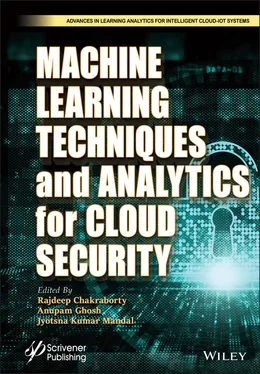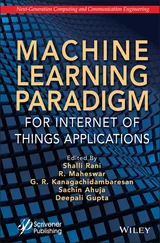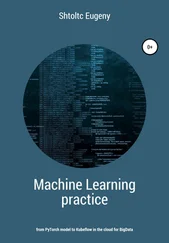Machine Learning Techniques and Analytics for Cloud Security
Здесь есть возможность читать онлайн «Machine Learning Techniques and Analytics for Cloud Security» — ознакомительный отрывок электронной книги совершенно бесплатно, а после прочтения отрывка купить полную версию. В некоторых случаях можно слушать аудио, скачать через торрент в формате fb2 и присутствует краткое содержание. Жанр: unrecognised, на английском языке. Описание произведения, (предисловие) а так же отзывы посетителей доступны на портале библиотеки ЛибКат.
- Название:Machine Learning Techniques and Analytics for Cloud Security
- Автор:
- Жанр:
- Год:неизвестен
- ISBN:нет данных
- Рейтинг книги:3 / 5. Голосов: 1
-
Избранное:Добавить в избранное
- Отзывы:
-
Ваша оценка:
- 60
- 1
- 2
- 3
- 4
- 5
Machine Learning Techniques and Analytics for Cloud Security: краткое содержание, описание и аннотация
Предлагаем к чтению аннотацию, описание, краткое содержание или предисловие (зависит от того, что написал сам автор книги «Machine Learning Techniques and Analytics for Cloud Security»). Если вы не нашли необходимую информацию о книге — напишите в комментариях, мы постараемся отыскать её.
This book covers new methods, surveys, case studies, and policy with almost all machine learning techniques and analytics for cloud security solutions
Audience The aim of Machine Learning Techniques and Analytics for Cloud Security
Machine Learning Techniques and Analytics for Cloud Security — читать онлайн ознакомительный отрывок
Ниже представлен текст книги, разбитый по страницам. Система сохранения места последней прочитанной страницы, позволяет с удобством читать онлайн бесплатно книгу «Machine Learning Techniques and Analytics for Cloud Security», без необходимости каждый раз заново искать на чём Вы остановились. Поставьте закладку, и сможете в любой момент перейти на страницу, на которой закончили чтение.
Интервал:
Закладка:
Thus, motivation of this review is to provide a broad details of hybrid cloud computing, why it is gaining popularity, how business is going to be affected through the use of cloud adaption in near future, what security aspects need to dealt by vendors, and how AI can help in this regard. The following sections deal with all this topics.
1.2 Hybrid Cloud
If we go by the definition of National Institute of Standards and Technology [3], hybrid cloud is a “composition of two or more different types of cloud infrastructure that are bind together with the help of proprietary and standardized technology for the purpose of data and application portability. So, Simple amalgamation of cloud and on-premise data should not misinterpret as hybrid cloud. It should also provide the following facilities [2]:
Workload distribution by portability.
Networking between system and devices, by the use of LAN, WAN, or VPN.
Use of a comprehensive unified automation tool.
A complex powerful middleware for abstracting the background details.
Incorporating availability and scalability of resources.
Integrating disaster management and recovery strategies.
Thus, it enables the customer to extend their business by leveraging the attractive services provided by public cloud as well as securing the delicate data through the use of private cloud. When the demand of a business fluctuates that may be sudden peak in the business come or sudden fall down, in those scenarios, hybrid cloud is the best possible option as it has that flexibility [8]. Organizations can seamlessly use public cloud amenities without directly giving access to their data centers which are part of their on-premise servers. So, business critical data and applications can be kept safe behind, while computing power of the public cloud can be used for doing complex tasks. Organizations will only have to pay for the services it is using without considering the capital expenditure involve in purchasing, programming and maintaining new resources which can be used for a short span of time and may remain idle for long. Private cloud on the other hand is more like public cloud, but generally installed on clients datacenter and mainly focus on self-servicing, scalable structure. Single tone service nature, service-level agreement (SLA), and similar association make the relationship between client and cloud stronger and less demanding [33, 34].
1.2.1 Architecture
There may be any combination of cloud services when to deploy a hybrid cloud. It may the client has its own on-premise private cloud as IaaS and leverage public cloud as SaaS. Private cloud may be on premise or sometimes off premise on a dedicated server [10]. There is no fixed fits for all architecture. Private clouds can be made individually, whereas public cloud can be hired from vendors like Amazon, Microsoft, Alibaba, Google, and IBM. Next, a middleware is required to combine public and private cloud mostly provided by the cloud vendors as a part of their package. Figure 1.1gives general diagram of a hybrid cloud.
In case of hybrid cloud architecture, the following is a list of properties that must to be kept in mind [4]:
1 a. Multiple devices need to be connected via LAN, WAN, or VPN with a common middleware that provides an API for user services. Rather than using a vast network of API, a single operating system must be used throughout the network and APIs can be built on top of that.
2 b. Resources are made available to all the connected devices via virtualization and it can be scaled up to any limit.
3 c. The middleware does all the coordination between devices and resources are made available on demand basis with proper authentication.
1.2.2 Why Hybrid Cloud is Required?
Hybrid cloud means different service to different people [5]. Need of an organization depends on diverse aspects of IT. As the perspective of application designer, business developer, and infrastructure support personnel is different from one another, their expectation from the system also varies.

Figure 1.1 General architecture of hybrid cloud.
Application programmer always requires support for edge technologies. Availability of high-end resources and cutting edge technology support is the primary concern of a developer. Off premise support for such is essential. Flexibility in deployment of changing technology services, speedy availability of the new resources required by the solution, peak support for on-premise system, and seamless and continuous integration of system services are key issues need to be dealt in hybrid cloud. Disaster management is also an integral part of it.
On the contrary, infrastructure support personnel always look for a steady build in support for smooth execution of overall activities of the organization. Off premise support for virtualized computing resources is often necessary in IT. In this scenario, the role of infrastructure support team is very crucial. Visibility of all the resources wherever it is, monitoring them in federated way following SLA, management of deployed setup for auditing and security management, accessibility of all resources, and control provisioning are key consideration in case of hybrid cloud.
Business developer, on the other hand, focuses on consumer marketing in cost-effective manner [6]. The need of IT business has manifolds. Support for newly growing technology like mobile or web-based application requires agile and easy to extend network, and at the same time, consistent system and stable process management services cannot be replaced. So, business developers have to look into all these aspects, and at the same time, they have to focus on the cost. The maintenance and management cost should not exceed the overall financial budget. Looking at the SLAs and software license exposure, they need to design financial plans that can fulfill the whole organization’s prerequisites.
No matter how well we plan the future, it still remains uncertain and hybrid cloud provides the facility to use cloud services as and when it is required. It is also quite unlikely that workload of an organization remains same throughout the whole year. Suppose an organization is working on big data analytics, it can take help of public cloud computing resources for high complex computations but that too is not needed for long run, may be require for few months. Here, public cloud resources can be borrowed for few months only. In the same way, startup companies can start with some trivial private resources and take cloud services for rest of the processing. Then, based on the performance, they can plan to expand the business with the help of public cloud. All these are possible only in case of hybrid cloud as it has agility, scalability, data reliability, speedy recovery, and improved connectivityand security.
1.2.3 Business and Hybrid Cloud
According to Hybrid Cloud Market report, in 2018, hybrid cloud market was USD 44.6 billion and expected to grow to USD 97.6 billion by the end of 2023 with Compound Annual Growth Rate (CAGR) of 17.0% [9]. IaaS is expected to hold a large market in the forecast period as it facilitates to migrate workload from on premise to off premise in high peak hours. Hybrid web hosting also hold a big market as it provides management of all hosting services in just single point of contact. North America was the most promising hybrid cloud market place in 2018 and Asia Pacific areas shows the highest CAGR. So, hybrid cloud is a promising area in business. Major sectors using hybrid cloud computing are healthcare, retail, government, or public sectors, banking, entertainment media, insurance, finance, communication media, etc. [14]. According to a report published by Mordor Intelligence, North America, Middle East, Africa, Europe, and Asia Pacific are top growing regions worldwide. Figure 1.2shows the hybrid cloud market. Green portions represent highly growing market. Hybrid cloud management software solution is the main reason of this popularity. Starting from deployment to quota management, customization of service library, costing, performance management, and governance, everything is taken care of, like the software management tool. Mostly, the services provided by public providers are restricted to some architecture or technology and vendor specific. But the management tool provided by hybrid providers helps to amalgamate different services provided by various vendors. Amazon and Microsoft, the giants in this field, are working hard in the up gradation of their management software by including advanced infrastructure templates, libraries, API, and apps. In India, IBM is also approaching toward hybrid cloud and AI [15]. IBM invested $1 billion into a cloud ecosystem project in the month of August. They are expected to invest more in the coming time. In India, 17% of organizations are planning to spend investment from 42% to 49% on hybrid cloud by 2023 according to a study by IBM IBV. Since India is heading toward a digital transformation and self-reliant camping, so the opportunity of new technology adaptation also increasing.
Читать дальшеИнтервал:
Закладка:
Похожие книги на «Machine Learning Techniques and Analytics for Cloud Security»
Представляем Вашему вниманию похожие книги на «Machine Learning Techniques and Analytics for Cloud Security» списком для выбора. Мы отобрали схожую по названию и смыслу литературу в надежде предоставить читателям больше вариантов отыскать новые, интересные, ещё непрочитанные произведения.
Обсуждение, отзывы о книге «Machine Learning Techniques and Analytics for Cloud Security» и просто собственные мнения читателей. Оставьте ваши комментарии, напишите, что Вы думаете о произведении, его смысле или главных героях. Укажите что конкретно понравилось, а что нет, и почему Вы так считаете.












